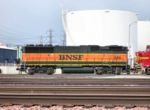Rail terminology
| Globe icon | The examples and perspective in this article or section may not represent a worldwide view of the subject. Please improve this article or discuss the issue on the talk page. |
| Rail transport |
|---|
| Operations |
| Stations |
| Trains |
| Locomotives |
| Rolling stock |
| History |
| Terminology |
| By country |
| Disasters |
|
|
| Rail terminology |
|---|
|
Rail terminology is a form of technical terminology. The difference between the American term railroad and the British term railway (also used by other English-speaking countries outside the US) is the most obvious trans-Atlantic difference in rail terminology (see usage of the terms railroad and railway for more information). There are also others, due to the parallel development of rail transport systems on both sides of the Atlantic. Various terms are presented here alphabetically; where a term has multiple names, this is indicated. The note "US" indicates a term peculiar to North America, or "CA" may represent Canada while "UK" refers to terms originating in the British Isles and normally also used in former British colonies outside North America (such as Australia "AU", New Zealand "NZ", etc.). Exceptions are noted; terms whose currency is limited to one particular country, region, or railway are also included. |
|
|
| Contents: | Top - 0–9 A B C D E F G H I J K L M N O P Q R S T U V W X Y Z |
|---|
0-9
- Note: for 4-4-0, 2-6-4T, 0-4-4-0, etc. See Whyte notation or UIC classification
| Definitions | Points of Interest |
|---|---|
|
A
| Definitions | Points of Interest |
|---|---|
|
File:440woodcut.jpg An American class steam locomotive File:Cupola caboose.jpg A Cupola style Caboose. Note the Angel Seat above. File:AEITag.jpg An Automatic Equipment Identification (AEI) Tag attached to a freight car. File:ETTX 905721 20050529 IL Rochelle.jpg A string of TTX Autorack cars in service |
| Contents: | Top - 0–9 A B C D E F G H I J K L M N O P Q R S T U V W X Y Z |
|---|
B
| Definitions | Points of Interest |
|---|---|
|
File:BNSF-badorder.jpg An example of a BNSF Railway bad order repair tag
File:DRG bobber caboose at CRM.jpg A "Bobber" 4-wheel caboose of the Denver & Rio Grande Railroad preserved at the Colorado Railroad Museum, Golden, Colorado.
File:Bettendorf truck at Illinois Railway Museum.JPG Bettendorf-type freight car bogie; note the solid bearings around the ends of the axles.
File:Highslug.jpg A CSX cab version of a Diesel-electric Slug' often called a Booster Unit; note the missing radiator and the one piece side panels in lieu of door panels. |
| Contents: | Top - 0–9 A B C D E F G H I J K L M N O P Q R S T U V W X Y Z |
|---|
C
| Definitions | Points of Interest |
|---|---|
|
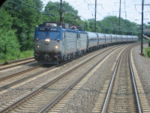 An electric Amtrak train with two AEM-7 locomotives running through New Jersey on the Northeast Corridor. The catenary system is clearly visible. File:Tow hitch 5.jpg An AAR Type "E" railroad car coupler. (US) |
| Contents: | Top - 0–9 A B C D E F G H I J K L M N O P Q R S T U V W X Y Z |
|---|
D
| Definitions | Points of Interest |
|---|---|
|
| Contents: | Top - 0–9 A B C D E F G H I J K L M N O P Q R S T U V W X Y Z |
|---|
E
| Definitions | Points of Interest |
|---|---|
|
File:BN 3157 IL Eola.jpg Three BN locomotives coupled elephant style". |
| Contents: | Top - 0–9 A B C D E F G H I J K L M N O P Q R S T U V W X Y Z |
|---|
F
| Definitions | Points of Interest |
|---|---|
|
File:Loaded flat cars, covered loads.jpg A train of loaded flatcars. 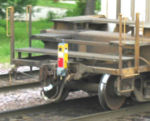 A FRED Flashing rear-end device File:Demonstrating fusee use.jpg A brakeman uses a fusee to demonstrate a hand signal indicating "stop". |
| Contents: | Top - 0–9 A B C D E F G H I J K L M N O P Q R S T U V W X Y Z |
|---|
G
| Definitions | Points of Interest |
|---|---|
|
File:NZR g class garratt.jpg A Garratt locomotive. File:3801.jpg An EMD GP38-2, "General Purpose" (GP) locomotives are often called a "Geep". File:CW 5097 at Rochelle, IL, 20040718.jpg A Gondola type of railroad car. |
| Contents: | Top - 0–9 A B C D E F G H I J K L M N O P Q R S T U V W X Y Z |
|---|
H
| Definitions | Points of Interest |
|---|---|
|
File:RCBTHandcar.jpg A handcar (pump trolley UK) |
| Contents: | Top - 0–9 A B C D E F G H I J K L M N O P Q R S T U V W X Y Z |
|---|
I
| Definitions | Points of Interest |
|---|---|
|
File:Des Plaines interlocking tower.jpg The interlocking tower and tracks at Des Plaines, Illinois, in 1993. File:Vonsvans01022.jpg A train of intermodal trailers on flat cars. Also see TOFC |
| Contents: | Top - 0–9 A B C D E F G H I J K L M N O P Q R S T U V W X Y Z |
|---|
J
| Definitions | Points of Interest |
|---|---|
|
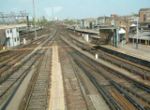 Clapham Junction Railway Station. Acute end of the Railway Junction London, England. |
| Contents: | Top - 0–9 A B C D E F G H I J K L M N O P Q R S T U V W X Y Z |
|---|
K
| Definitions | Points of Interest |
|---|---|
|
| Contents: | Top - 0–9 A B C D E F G H I J K L M N O P Q R S T U V W X Y Z |
|---|
L
| Definitions | Points of Interest |
|---|---|
|
File:CNW brakeman's kerosene lantern.JPG A brakeman's lantern from the Chicago and North Western Railway; this lantern burned kerosene to produce light. |
| Contents: | Top - 0–9 A B C D E F G H I J K L M N O P Q R S T U V W X Y Z |
|---|
M
| Definitions | Points of Interest |
|---|---|
|
File:BNSF X4400320 20040808 WI Prairie du Chien.jpg A Spiker part of a fleet of Maintenance of way vehicles. |
| Contents: | Top - 0–9 A B C D E F G H I J K L M N O P Q R S T U V W X Y Z |
|---|
N
| Definitions | Points of Interest |
|---|---|
|
| Contents: | Top - 0–9 A B C D E F G H I J K L M N O P Q R S T U V W X Y Z |
|---|
O
| Definitions | Points of Interest |
|---|---|
|
File:Bathtub gondola at Rochelle.jpg Open wagon Gondola style freight car. |
| Contents: | Top - 0–9 A B C D E F G H I J K L M N O P Q R S T U V W X Y Z |
|---|
P
| Definitions | Points of Interest |
|---|---|
|
 A Pannier tank steam locomotive. |
| Contents: | Top - 0–9 A B C D E F G H I J K L M N O P Q R S T U V W X Y Z |
|---|
Q
| Definitions | Points of Interest |
|---|---|
| Contents: | Top - 0–9 A B C D E F G H I J K L M N O P Q R S T U V W X Y Z |
|---|
R
| Definitions | Points of Interest |
|---|---|
|
File:Union-station.jpg A Railroad Station. Union Station, Washington D.C. |
| Contents: | Top - 0–9 A B C D E F G H I J K L M N O P Q R S T U V W X Y Z |
|---|
S
| Definitions | Points of Interest |
|---|---|
|
File:CEBX800.jpg CEBX 800, the largest railroad Schnabel car ever built at over 800 tons capacity. File:Rail-semaphore-signal-Dave-F.jpg British lower-quadrant semaphore stop signal (absolute) with subsidiary arm (permissive) below. File:CSX color position light Savage MD.jpg Two-head color position signal on CSXT mainline at Savage, Maryland. The left head displays "Stop", the right head, "Clear". File:Speeder at MadCity Rail Show 2004.jpg A privately-owned speeder on display at the Mad City Model Railroad Show and Sale in Madison, Wisconsin, February 2004. File:Railroad spikes.JPG Two unused and one heavily corroded spikes. The measurement scale shown is inches.  A pair of EMD SW900 switchers |
| Contents: | Top - 0–9 A B C D E F G H I J K L M N O P Q R S T U V W X Y Z |
|---|
T
| Definitions | Points of Interest |
|---|---|
|
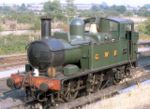 A side mounted tank engine
File:Finnish460.jpg A Finnish ten-wheeler.
File:Rail track tamper - DR73238 - Jarvis Fastline livery - Chester railway station - 2005-10-09.jpg A track tamping machine in the sidings at Chester railway station |
| Contents: | Top - 0–9 A B C D E F G H I J K L M N O P Q R S T U V W X Y Z |
|---|
U
| Definitions | Points of Interest |
|---|---|
|
File:Cincinnati-union-terminal.jpg The main concourse building and facade of Cincinnati Union Terminal. |
| Contents: | Top - 0–9 A B C D E F G H I J K L M N O P Q R S T U V W X Y Z |
|---|
V
| Definitions | Points of Interest |
|---|---|
|
File:Boxcar railbox.jpg A Boxcar (US) Goods van (UK): rolling stock, used to transport freight. |
| Contents: | Top - 0–9 A B C D E F G H I J K L M N O P Q R S T U V W X Y Z |
|---|
W
| Definitions | Points of Interest |
|---|---|
|
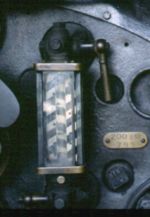 Water gauge. Here the water is at the “top nut”, the maximum working level. File:Double Whistle post.jpg A double Whistle post located on the Grand Trunk Western Railroad. File:Wye.jpg Satellite image of a wye where two approaches to the interchange have been abandoned. |
| Contents: | Top - 0–9 A B C D E F G H I J K L M N O P Q R S T U V W X Y Z |
|---|
X
| Definitions | Points of Interest |
|---|---|
|
File:RR Xing Sign.jpg A Railroad Crossing (X-ing) sign in Belton, Missouri. |
| Contents: | Top - 0–9 A B C D E F G H I J K L M N O P Q R S T U V W X Y Z |
|---|
Y
| Definitions | Points of Interest |
|---|---|
|
File:CNW yard, Chicago.jpg A railroad yard in Chicago, Illinois, (Proviso Yard) operated by the Chicago and North Western Railway as seen in December 1942. |
| Contents: | Top - 0–9 A B C D E F G H I J K L M N O P Q R S T U V W X Y Z |
|---|
Z
| Definitions | Points of Interest |
|---|---|
|
| Contents: | Top - 0–9 A B C D E F G H I J K L M N O P Q R S T U V W X Y Z |
|---|
See also
- List of US railfan jargon
- List of UK railfan jargon
- List of NZ railfan jargon
- Transmodel CEN standard for Public Transport Information concepts and terminology
References
- ↑ www.doverharbor.com National Railway Historical Society, Washington D.C. Chapter, Inc. permission Kevin J. Tankersley
- ↑ Union Pacific Railroad. Fun Facts. Retrieved on 2007-03-05.

